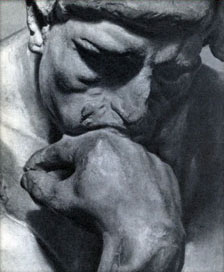Meinong Alexius (1853–1920), Austrian philosopher and psychologist, founder of Gegenstandstheorie, the theory of (existent and nonexistent intended) objects. He was the target of Russell’s criticisms of the idea of non-existent objects in his landmark essay ‘On Denoting’ (1905).
Meinong, after eight years at the Vienna Gymnasium, enrolled in the University of Vienna in 1870, studying German philology and history and completing a dissertation (1874) on Arnold von Brescia. After this period he became interested in philosophy as a result of his critical selfdirected reading of Kant. At the suggestion of his teacher Franz Brentano, he undertook a systematic investigation of Hume’s empiricism, culminating in his first publications in philosophy, the Hume-Studien I, II (1878 and 1882). In 1882, Meinong was appointed Professor Extraordinarius at the University of Graz (receiving promotion to Ordinarius in 1889), where he remained until his death. At Graz he established the first laboratory for experimental psychology in Austria, and was occupied with psychological as well as philosophical problems throughout his career. The Graz school of phenomenological psychology and philosophical semantics, which centered on Meinong and his students, made important contributions to object theory in philosophical semantics, metaphysics, ontology, value theory, epistemology, theory of evidence, possibility and probability, and the analysis of emotion, imagination, and abstraction.
Meinong’s object theory is based on a version of Brentano’s immanent intentionality thesis, that every psychological state contains an intended object toward which the mental event (or, in a less common terminology, a mental act) is semantically directed. Meinong, however, rejects Brentano’s early view of the immanence of the intentional, maintaining that thought is directed toward transcendent mind-independent existent or non-existent objects. Meinong distinguishes between judgments about the being (Sein) of intended objects of thought, and judgments about their ‘so-being,’ character, or nature (Sosein). He claims that every thought is intentionally directed toward the transcendent mind-independent object the thought purports to be ‘about,’ which entails that in at least some cases contingently non-existent and even impossible objects, for instance Berkeley’s golden mountain and the round square, must be included as non-existent intended objects in the object theory semantic domain. Meinong further maintains that an intended object’s Sosein is independent of its Sein or ontological status, of whether or not the object happens to exist. This means, contrary to what many philosophers have supposed, that non-existent objects can truly possess the constitutive properties predicated of them in thought.
Meinong’s object theory evolved over a period of years, and underwent many additions and revisions. In its mature form, the theory includes the following principles: (1) Thought can freely (even if falsely) assume the existence of any describable object (principle of unrestricted free assumption, or unbeschränkten Annahmefreiheit thesis); (2) Every thought is intentionally directed toward a transcendent, mind-independent intended object (modified intentionality thesis); (3) Every intended object has a nature, character, Sosein, ‘how-it-is,’ ‘so-being,’ or ‘being thus-and-so,’ regardless of its ontological status (independence of Sosein from Sein thesis); (4) Being or non-being is not part of the Sosein of any intended object, nor of an object considered in itself (indifference thesis, or doctrine of the Aussersein of the homeless pure object); (5) There are two modes of being or Sein for intended objects: (a) spatiotemporal existence and (b) Platonic subsistence (Existenz/Bestand thesis); (6) There are some intended objects that do not have Sein at all, but neither exist nor subsist (objects of which it is true that there are no such objects). Object theory, unlike extensionalist semantics, makes it possible, as in much of ordinary and scientific thought and language, to refer to and truly predicate properties of non-existent objects. There are many misconceptions about Meinong’s theory, such as that reflected in the objection that Meinong is a super-Platonist who inflates ontology with non-existent objects that nevertheless have being in some sense, that object theory tolerates outright logical inconsistency rather than mere incompatibility of properties in the Soseine of impossible intended objects. Russell, in his reviews of Meinong’s theory in 1904–05, raises the problem of the existent round square, which seems to be existent by virtue of the independence of Sosein from Sein, and to be non-existent by virtue of being globally and simultaneously both round and square. Meinong’s response involves several complex distinctions, but it has been observed that to avoid the difficulty he need only appeal to the distinction between konstitutorisch or nuclear and ausserkonstitutorisch or extranuclear properties, adopted from a suggestion by his student Ernst Mally (1878–1944), according to which only ordinary nuclear properties like being red, round, or ten centimeters tall are part of the Sosein of any object, to the exclusion of categorical or extranuclear properties like being existent, determinate, possible, or impossible. This avoids counterexamples like the existent round square, because it limits the independence of Sosein from Sein exclusively to nuclear properties, implying that neither the existent nor the nonexistent round square can possibly have the (extranuclear) property of being existent or nonexistent in their respective Soseine, and cannot be said truly to have the properties of being existent or non-existent merely by free assumption and the independence of Sosein from Sein. See also BRENTANO, EXTENSIONALISM , FORMAL SEMANTICS , INTENTIONALITY , META – PHYSIC. D.J.
